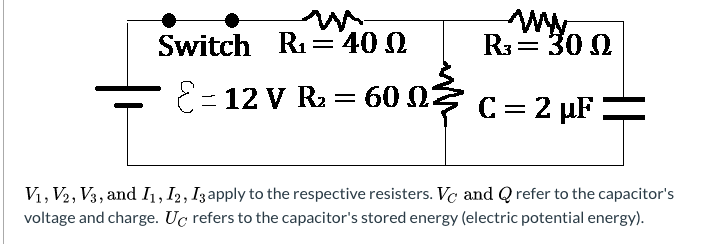Switch R1=40 0 R3= 30 2 60 03 E= 12 V R2 C = 2 µF = V1, V2, V3, and 1, I2, I3apply to the respective resisters. Vc and Q refer to the capacitor's voltage and charge. Uc refers to the capacitor's stored energy (electric potential energy).
The remaining circuit quantities may change instantaneously as required by Kirchhoff's rules. Calculate I1 , I2 , and I3 in amps immediately after the switch ( t = 0 + ), in that order. Finally, calculate Q in uC. (All currents in this and the following two should be positive.)

Capacitor is an electrical component in a circuit which stores charges. How do these capacitors get charged? The answer is, there must be some charge supplier like battery. So, the battery charge capacitor by creating a potential difference so that charges start to move from higher potential to lower potential.
When a capacitor is not charged, it will behave as plain wire. Reason for this is, when the capacitor is uncharged, there is no charge on it, so there will be no repulsion for the incoming charge on capacitor.
Capacitor Initially: behaves like a plain wire
When a capacitor is fully charged, it will behave as open circuit. Reason for this is, when a capacitor is fully charged, there will be huge repulsion from the charges stored in capacitor for the incoming charges on capacitor. As the capacity of the capacitor is full when it is fully charged, so there is no scope of any extra charge to pass through the capacitor. So, no charge will be allowed to pass though the capacitor, and it will behave like an open circuit.
Capacitor Finally: behaves like an open circuit
Final condition of the capacitor
When the voltage across the capacitor will become equal to the voltage across 60, then both will be at same potential, resulting in no current flow through capacitor.
Q=CV
Q = charge on the capacitor
C = capacitor
V = voltage across capacitor
Step by step
Solved in 4 steps with 2 images









